
One of the humans’ most devastating mental conditions is becoming addicted to substance use. Addiction can lead to a loss of senses, identity, and reality.
Escaping reality is the most common reason for the cause of addiction to alcohol, drugs, and many other substances.
According to a WHO survey conducted in 2015:
- 1 Billion people are addicted to tobacco.
- 15 million people are addicted to other kinds of drugs.
- 240 million people are addicted to alcohol.
However, addiction recovery is challenging and demands ongoing motivation, support, and resource access. With the rapid growth of mobile applications, addiction recovery apps emerge as a valuable tool in helping individuals on their path to recovery.
These apps solve various addictions, including alcoholism, substance abuse, gambling, and more.
With the integration of evidence-based practices, self-help techniques, and connectivity features, addiction recovery apps aims to empower individuals, improve their chances of long-term sobriety and enhance their recovery experience.
Addiction recovery app development facilitates a great opportunity for anyone seeking to profit in this industry.
Explore the steps to start addiction recovery app development, must-have features and functionalities, and how these apps can contribute to recovery.
- What Are Addiction Recovery Apps?
- How Does An Addiction Recovery App Work?
- Must-Have Features For Addiction Recovery Apps
- Steps To Development An Addiction Recovery App
- Top 5 Addiction Recovery Mobile Apps
- Tech Stack To Build An Addiction Recovery App
- How Much Does It Cost To Build An App For Addiction Recovery?
- Conclusion
- FAQ
What Are Addiction Recovery Apps?
Addiction Recovery apps are mobile applications tailored to support individuals in their journey toward addiction recovery and maintaining long-term sobriety.
These kinds of apps leverage the power of technology to provide enormous features and tools that can help users to manage their addictions, track progress, stay motivated, and access resources and support networks.
How Does An Addiction Recovery App Work?
An addiction recovery app is a mobile application designed to support individuals in their journey toward overcoming addiction and maintaining recovery. These apps typically offer a range of features and resources to assist users in various aspects of their recovery process. Here’s an overview of how an addiction recovery app typically works:
1. Goal Setting
The app allows users to set goals related to their recovery, such as abstinence from substances, improving mental well-being, or building healthier habits. Users can establish specific targets and track their progress over time.
2. Daily Tracking
Users can record their daily activities, behaviors, and emotions relevant to their recovery journey. This may include logging substance use, cravings, mood, exercise, meditation, or other activities. Tracking helps users gain insight into patterns, triggers, and progress.
3. Supportive Content
Addiction recovery apps often provide educational content, articles, videos, or audios to educate and motivate users. These resources may cover topics such as addiction science, coping strategies, relapse prevention, self-care, and mental health.
4. Personal Journaling
Some apps include a feature for users to maintain a personal journal. Writing down thoughts, feelings, and experiences can serve as a therapeutic tool, promote self-reflection, and assist in identifying triggers and coping strategies.
5. Peer Support and Community
Many addiction recovery apps foster a sense of community by offering discussion forums, chat rooms, or peer support networks. Users can connect with others who are going through similar experiences, share insights, provide encouragement, and seek advice.
6. Sobriety Clock and Milestones
The app may include a sobriety clock that tracks the length of time the user has remained abstinent from substances. It can also celebrate milestones and achievements, providing positive reinforcement and motivation.
7. Coping Tools and Techniques
Addiction recovery apps often feature coping tools and techniques to help users manage cravings, stress, and difficult emotions. These may include guided meditations, breathing exercises, relaxation techniques, or cognitive-behavioral exercises.
8. Reminders and Notifications
The app can send reminders and notifications to help users stay on track with their recovery goals. These reminders may include taking medication, attending support group meetings, practicing self-care, or engaging in healthy activities.
9. Access to Resources
Addiction recovery apps may provide links or references to additional resources, such as helplines, treatment centers, therapists, or support groups. Users can easily access these resources when needed.
10. Data Analysis and Progress Reports
Some apps analyze the data collected from user input and provide progress reports, insights, and visualizations. This helps users better understand their recovery journey, identify patterns, and make informed decisions.
It’s important to note that addiction recovery apps are not a substitute for professional treatment or therapy. They are intended to complement and support a comprehensive recovery plan. Individuals seeking recovery should consult with healthcare professionals or addiction specialists for personalized guidance and treatment options next, let’s take a look at what features help these apps in subduing the addiction.
Must-Have Features For Addiction Recovery Apps
The apps comprise the following features that can help users to recover from their addictions.
1. User Authentication and Privacy
Implement a secure user authentication system to protect user data and ensure privacy. This can include features like secure login, password protection, and data encryption.
2. Intuitive User Interface
Design a user-friendly interface with clear navigation and intuitive controls. Make it easy for users to access different features, track their progress, and engage with the app.
3. Goal Setting and Progress Tracking
Include a feature that allows users to set recovery goals and track their progress. Provide visual representations, such as charts or graphs, to show milestones and achievements.
4. Daily Logging and Reminders
Enable users to log daily activities, cravings, emotions, and other relevant information. Incorporate reminder notifications to prompt users to log their data regularly.
5. Community and Peer Support
Integrate a platform for users to connect with each other, share experiences, and offer support. This can include discussion forums, chat functionality, or the ability to join virtual support groups.
6. Educational Resources
Include a library of educational content, articles, videos, or audios related to addiction recovery. Make it easy for users to access information on topics such as addiction science, coping strategies, and relapse prevention.
7. Coping Tools and Techniques
Provide practical tools and techniques to help users cope with cravings, stress, and difficult emotions. This can include guided meditations, breathing exercises, or interactive exercises for cognitive-behavioral therapy.
8. Personal Journaling
Incorporate a feature for users to maintain a personal journal within the app. Allow them to document their thoughts, feelings, and progress, providing a space for self-reflection and emotional processing.
9. Notifications and Reminders
Implement a notification system to send reminders, motivational messages, or encouraging quotes to users at appropriate times. This can help keep them engaged and motivated in their recovery journey.
10. Data Analysis and Insights
Use data analytics to analyze user input and provide personalized insights and progress reports. Help users identify patterns, triggers, and areas for improvement in their recovery process.
11. Integration with External Services
Consider integrating the app with external services, such as treatment centers, therapists, or support group directories. This can provide users with easy access to additional resources and support.
12. Offline Functionality and Syncing
Enable offline functionality so that users can access certain features and data even without an internet connection. Implement syncing capabilities to ensure data is saved and updated across multiple devices.
13. Accessibility Features
Ensure the app is accessible to users with different abilities. Incorporate features like adjustable font sizes, voiceover support, and compatibility with screen readers for visually impaired users.
14. Security and Compliance
Follow best practices for data security and comply with relevant privacy regulations, such as GDPR or HIPAA, if applicable. Protect user data and prioritize their privacy throughout the app’s development and maintenance.
15. Feedback and Support Channels
Provide a way for users to provide feedback, report issues, or seek technical support within the app. Implement a support system to address user inquiries promptly.
Steps To Development An Addiction Recovery App
Developing addiction recovery requires careful consideration and planning. The steps to build your app are as follows.
1. Identify your target audience
Determining a specific group of individuals or demographics for your app is crucial to target the right people. You can develop apps for people who want to recover from gambling addictions, substance abuse, or other addictive behavior.
Understanding your audience will help you develop and implement core features based on your audience’s needs and requirements.
2. Define app objectives and scope
The app objective can be defined by clearly outlining the goals of your apps, such as the problems your app will solve. Specific features and functionality that your app will consist of. How will your app help your audience to recover from addictions?
3. Conduct market research
Market research is crucial for identifying the strengths, weaknesses, and unique selling points of popular apps in the addiction recovery industry.
Moreover, conducting market research will help you prepare the list of features on your app for people struggling with their addictions.
4. Collaborate with addiction experts
The involvement of an addiction specialist, therapist, and healthcare professional is important in developing your addiction recovery mobile app.
Their expertise in addiction recovery can ensure your app will be aligned perfectly with evidence-based practices and provides meaningful support to your app users.
5. Design the user interface and user experience
Create a user-friendly interface that is intuitive and visually appealing. Consider the app’s navigation, layout, and color scheme. Prioritize simplicity and accessibility, as users in recovery may be dealing with cognitive or emotional challenges.
A perfectly crafted user interface for your app users is crucial to help them easily navigate and access all the features and functionalities of your addiction recovery platform.
Consider important elements of the user interface design practices such as app navigation, color scheme, layout, and prioritizing accessibility and simplicity for your mobile app.
6. Develop core features
Addiction recovery apps comprise core features on your apps such as educational resources, user profiles, progress tracking, coping mechanisms, support network, etc.
However, as discussed earlier, conducting market research is the best way to prepare the list of essential features for your addiction recovery mobile app.
7. Ensure data security and privacy
Offering a secure environment to protect users’ data and privacy is essential to winning their trust and letting them access your platform without worrying about personal information and privacy issues.
Consider following best app security practices such as encrypting sensitive information, regularly updating security protocols, and providing secure authentication.
8. Test and iterate
Smooth working of your app is essential to deliver your users the best platform experience, which can be achieved by properly testing every part of your addiction recovery app.
Conduct throughout testing to identify and fix bugs, performance problems, and usability issues. Also, consider getting feedback from potential users and beta testers to refine your app and address any areas of improvement.
9. Consider gamification elements
Gamification is the best way to drive user engagement on your app. Incorporate various gamification techniques, including achievements, progress, badges, reward system, etc.
The gamification will help your app users to achieve positive behaviors and provide a sense of accomplishment on your platform.
10. Provide ongoing support and updates
For enhancing the user experience on your platform even further, provide regular updates, add new features based on user feedback, and offer a reliable customer support system.
11. Collaborate with addiction recovery organizations
Educating your users about addiction recovery is crucial to help them achieve their personal goals. Try to partner with support groups, treatment centers, or relevant organizations to increase awareness regarding addiction recovery.
12. Market and promote your app
To expand the reach of your app among your target audience, consider developing a marketing strategy. There are multiple ways to an effective marketing strategy, such as utilizing various channels like online forums, social media, and healthcare communities.
Highlighting your app’s unique features and benefits can help you attract users seeking addiction recovery support.
We recommend you partner with a reliable app development company that can help you develop and launch your addiction recovery app.
The company will follow all the basic steps that we have discussed above. Also, the company may follow additional app development steps based on your project’s needs and requirements.
Top 5 Addiction Recovery Mobile Apps
Explore the examples of the best addiction recovery mobile apps for taking ideas and inspiration for your platform
1. I Am Sober
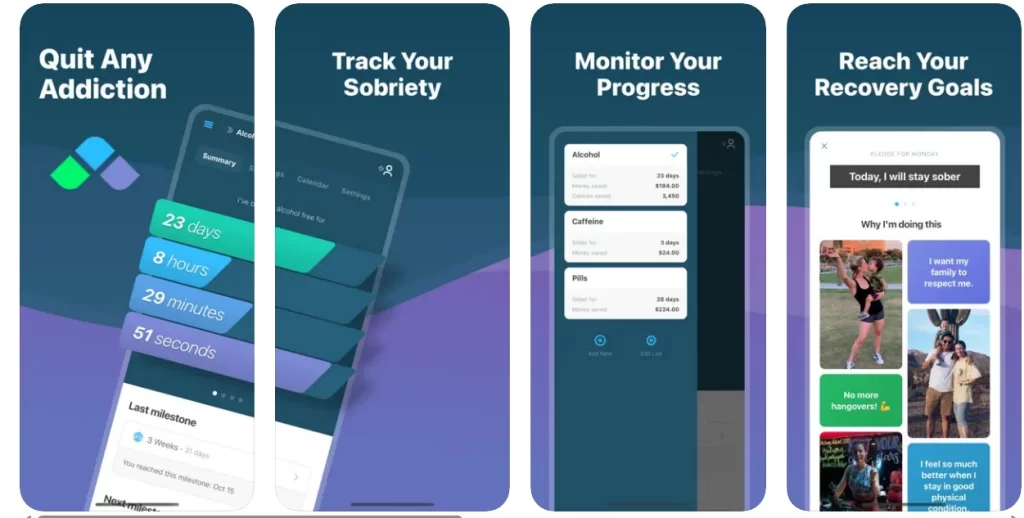
A sobriety-tracking app, helps users to monitor their progress and stay motivated in their journey toward addiction recovery. I am Sober app comprises valuable features such as a customizable progress tracker and sobriety calculator for helping users to maintain their sobriety.
| Founded in | 2018 |
| Available on | Android & iOS |
| Founded by | Andrew Murray |
| App Downloads | 1M+ |
| App Ratings | 4.7 |
| Headquarters | Washington, United States |
2. Quitzilla
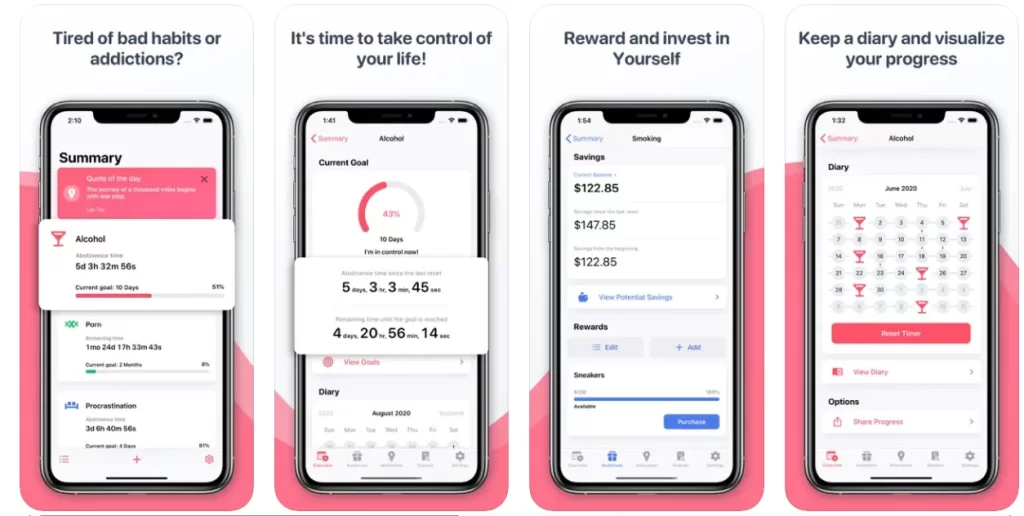
Quitzilla is a de-addiction app that helps individuals to quit smoking and track their progress. The app offers daily inspiration and community support to help users to stay motivated and achieve their goals of quitting smoking.
This application comprises valuable features such as a nicotine reduction tracker, a quit timeline, a cost calculator, etc.
| Founded in | 2017 |
| Available on | Android & iOS |
| Founded by | desDev |
| App Downloads | 1M+ |
| App Ratings | 4.7 |
| Headquarters | Lviv, Ukraine |
3. 12 Steps AA Companion
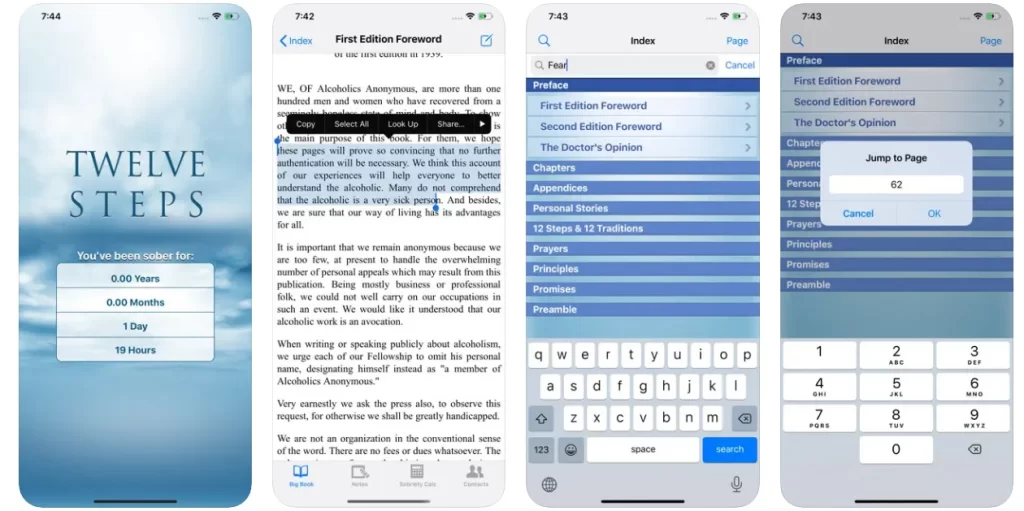
An addiction recovery app that provides addiction recovery support for individuals by advising them to follow the 12 steps of Alcoholics Anonymous(AA).
12 Steps AA companion offers a digital version of 12 steps, daily meditations, reflections, and journals to track progress. Moreover, the platform provides community support for users to help them recover and share their experiences.
| Founded in | 2008 |
| Available on | Android & iOS |
| Founded by | Dean Huff |
| App Downloads | 50K |
| App Ratings | 4.8 |
| Headquarters | United States |
4. Recovery Path
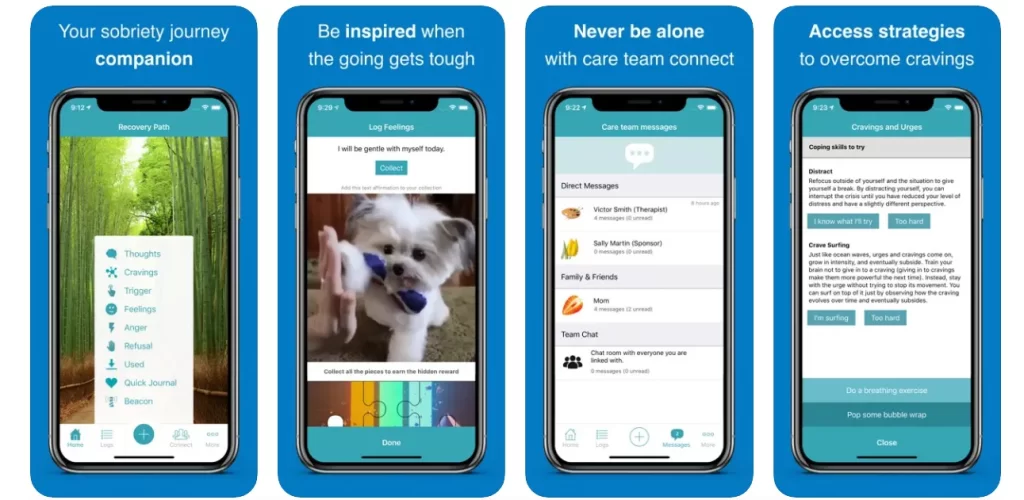
Recovery Path is an addiction recovery and mental health app with personalized treatment plans and support. The app facilitates valuable features such as journaling, progress tracking, daily inspiration, and community support through a private and secure platform.
The platform utilizes cognitive behavioral therapy and mindfulness techniques to help users to overcome addiction and improve their mental well-being.
| Founded in | 1999 |
| Available on | Android & iOS |
| Founded by | Recovery Records |
| App Downloads | 100K |
| App Ratings | 4.8 |
| Headquarters | California, United States |
5. Sober Grid
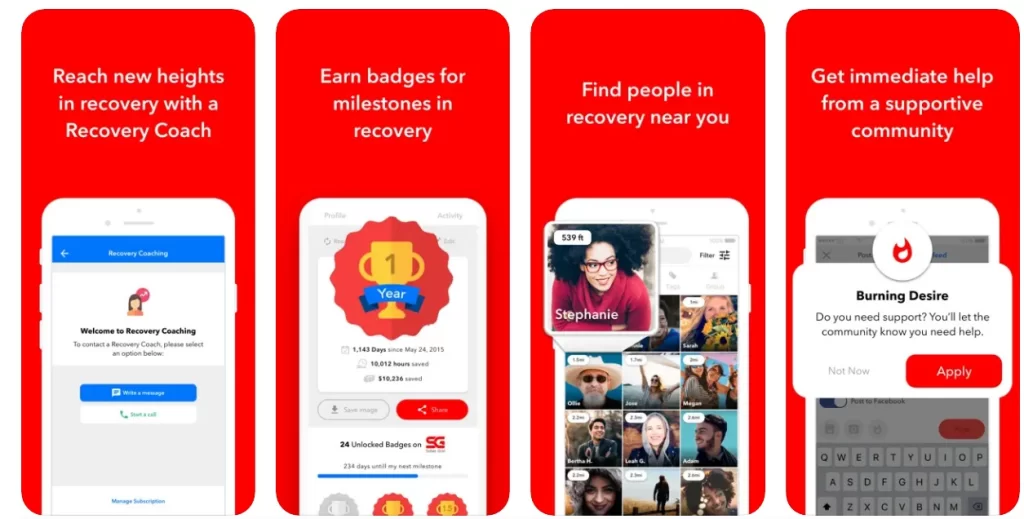
A social networking app that is designed specifically for people that are motivated to recover from specific addictions.
The app enables their users to share their recovery progress with other users, along with enabling them to create posts for providing and receiving support from their networks.
24/7 live peer coaching is one of the most remarkable features of this platform, where certified and trained peer coaches provide users with constant live support 365 days out of the year.
| Founded in | 2015 |
| Available on | Android & iOS |
| Founded by | Beau Mann |
| App Downloads | 100K |
| App Ratings | 4.1 |
| Headquarters | Massachusetts, United States |
Tech Stack To Build An Addiction Recovery App
Technology stack comprises tools and technologies that can facilitate mobile app development.
Employing a reliable app development company can help you utilize the right tools and technologies for developing your app based on your project requirements.
However, the recommended tech stack for developing an addiction recovery app is as follows.
| Cross platform mobile app | React Native or Flutter |
| Web app | Javascript, CSS, HTML |
| Server Side App | JS or Django |
| Handling user data & authentication | Firebase or AWS |
| Connecting Front End & Back End | REST APIs |
| Database | MongoDB or Postgre SQL |
| Push Notifications | Firebase Cloud Messaging |
| Analytics | Google Analytics or Mixpanel |
| Integrating with device’s health sensors | Healthkit or Google Fit |
| SMS communication with users | Twilio or Plivo |
| Version control | Git |
| Project management | Agile Methodology |
How Much Does It Cost To Build An App For Addiction Recovery?
Building an app for addiction recovery can vary in cost depending on various factors. Here are some key points to consider when estimating the cost:
1. Platform and Technology
The choice of platform (iOS, Android, or both) and the technology stack used to develop the app can impact the cost. Native app development tends to be more expensive compared to hybrid or cross-platform development.
2. Features and Functionality
The complexity and number of features required in the app will influence the development cost. Some common features in addiction recovery apps include progress tracking, goal setting, motivational content, educational resources, community support, and access to professional help.
3. Design and User Experience (UX)
A well-designed and user-friendly app is crucial for engagement and a positive user experience. Investing in professional app design and UX/UI development can impact the overall cost.
4. Backend Development and Infrastructure
The development of a robust backend system to handle user data, analytics, and connectivity with external resources or APIs will add to the development cost.
5. Integration of Third-party Services
If the app requires integration with third-party services such as payment gateways, social media platforms, or data analytics tools, the cost may increase based on the complexity of the integrations.
6. Security and Compliance
An addiction recovery app may need to comply with security standards and regulations to protect user data and maintain privacy. Implementing proper security measures and ensuring compliance can contribute to the cost.
7. Maintenance and Updates
Once the app is developed, ongoing maintenance, bug fixes, updates, and potential feature enhancements will require additional investment.
8. Testing and Quality Assurance
Thorough testing and quality assurance processes are essential for a stable and reliable app. Allocating resources and time for testing will impact the overall cost.
It’s important to note that the actual cost of developing an addiction recovery app can vary significantly based on the unique requirements of the project and the expertise of the development team. To consult with app development professionals or agencies for a more accurate cost estimate for your specific needs contact us via the form or cta below.
Conclusion
Addiction recovery app development has significantly contributed to supporting individuals on their journey to overcoming addiction. Users can leverage valuable features and tools from addiction recovery apps to manage their addictions and experience desirable outcomes.
As technology advances, addiction recovery apps have the potential to evolve further and provide even more tailored and effective support for helping users with addiction recovery.
Anyone looking to make money in this sector has a fantastic chance with app development, thanks to the emergence of addiction rehabilitation apps.
However, building an app requires years of expertise and industry knowledge that only an app development company can have.
Partner with a reliable app development company like Idea Usher. The company can help you develop your addiction recovery app and incorporate all the required features.
Our team comprises app developers and project managers who will work on your app development and facilitate support at each stage, from market research to app launch.
Contact us today to understand how we can help you start and expand your addiction recovery business.
Contact Idea Usher
Email:
Phone:
FAQ
Q: What are the benefits of developing an addiction recovery app?
- Accessibility: Users can access support and resources anytime, anywhere.
- Anonymity: Some individuals may prefer seeking help discreetly through an app.
- Personalization: Apps can tailor content and features to individual needs.
- Motivation and accountability: Features like goal tracking and progress monitoring can enhance motivation and accountability.
Q: How long does it take to develop an addiction recovery app?
A: The development timeline for an addiction recovery app can vary depending on factors such as complexity, features, and technology. Typically, it can take anywhere from a few months to a year or more to develop a fully functional app.
Q: Can an addiction recovery app replace traditional therapy or treatment?
A: An addiction recovery app should not be seen as a substitute for professional therapy or treatment. It can complement existing treatment by providing additional support and resources, but it is not a replacement for professional care.
Q: How do addiction recovery apps ensure user privacy and security?
A: Privacy and security are paramount in addiction recovery apps. App developers should implement measures like data encryption, secure user authentication, and adherence to relevant privacy laws and regulations to safeguard user information.
Q: Can an addiction recovery app be customized for specific treatment programs or organizations?
A: Yes, addiction recovery apps can be customized to align with specific treatment programs or organizations. This allows the app to cater to the unique needs and approach of the program or organization it is developed for.
Q: How do addiction recovery apps foster peer support and community engagement?
A: Addiction recovery apps can include features such as forums, chat rooms, or virtual support groups to facilitate peer support and community engagement. These features encourage users to connect, share experiences, and provide mutual support.










Gaurav Patil